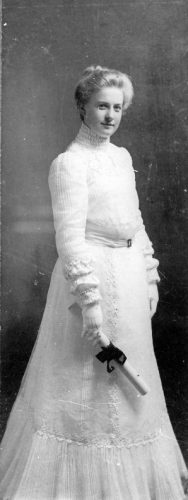 by Sarah Nathe, Kelley House Museum Board Member
by Sarah Nathe, Kelley House Museum Board Member
The French may be glad to die for love, as the old song goes, but Auggie Heeser was willing to live for it — a very long time. Heeser, son of pioneer Mendocino Beacon publisher, William Heeser, fell in love with Edith Nichols when he was 21 and she 15 (Beacon, June 29, 1956), but 50 years passed before she married him. Dante met Beatrice when he was nine years old and burned with love for her until she died 16 years later, and Penelope waited 20 years for Ulysses to return home from the Trojan War. Yet those steadfast lovers can’t compare with Auggie — he carried the torch for Edith through half a century.
We don’t know whether he declared himself when they were young, or what she felt for him, but after her high school graduation in 1900, she left Mendocino for four years at UC Berkeley and then the wider world. Since Auggie was an only child and heir apparent, his fortunes were closely tied to his father’s extensive business enterprises in Mendocino County. When his father died in 1906, he took over editorship of the paper and management of many of his father’s other businesses. And he thought about Edith.
By that time, Edith was teaching at an Oakland high school and studying voice in hopes of becoming an opera singer. Daughter of prominent local businessman James Nichols, she had received musical education as a child in voice, violin and piano, and “it was only natural that she would continue with her studies” (Beacon, June 29, 1956). Before and after World War I, she travelled to Europe to work with German soprano and vocal instructor, Lilli Lehmann. Edith didn’t have enough volume to make it as an opera singer, but she had learned Lehmann’s famous vocal method, so she opened a studio in New York City in 1923 and began a long career there as a voice coach. Did she think about Auggie?
Edith was a singer, not a writer, so there is nothing in the Kelley House archives that sheds light on her feelings. But we know plenty about Auggie’s: he kept in touch with Edith and even visited her in New York from time to time. He wrote columns about his visits. According to one of his young associates, Auggie filled the Beacon attic “with boxes of a music periodical for vocalists, each issue of which held ads for Edith’s coaching classes. He had stashed them there for all the years of his bachelorhood, probably to sigh over the lovely photos of Edith they contained” (Beacon, August 4, 1977).
Finally, in the summer of 1948, when he was 71, Auggie had the pleasure of writing his own wedding announcement (Beacon, August 28, 1948): he acknowledged that he was “a very fortunate man to have gained the love and affection of Miss Edith Nichols” and he noted philosophically that “All things come to him who waits.” But why did he have to wait soooo long? Was Edith devoted to her career and her muse to the exclusion of a husband? Did it take her 50 years to decide she could trust the guy?? Auggie had really big ears—could they have hindered Cupid’s arrow???
To explore this, and other sweet mysteries of Mendocino life, visit the Kelley House Museum and archives. The course of true love never did run smooth, but it’s always fascinating!